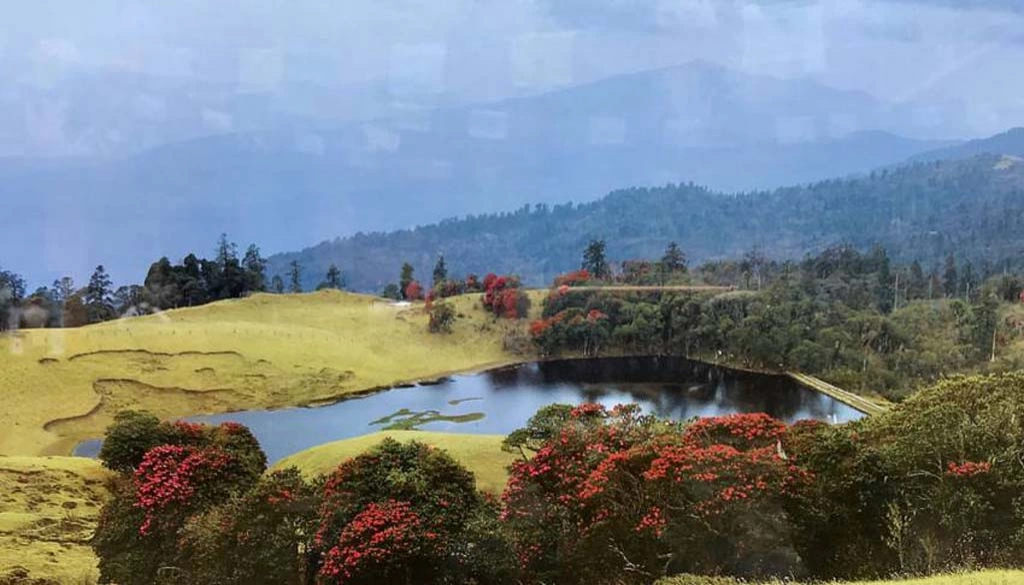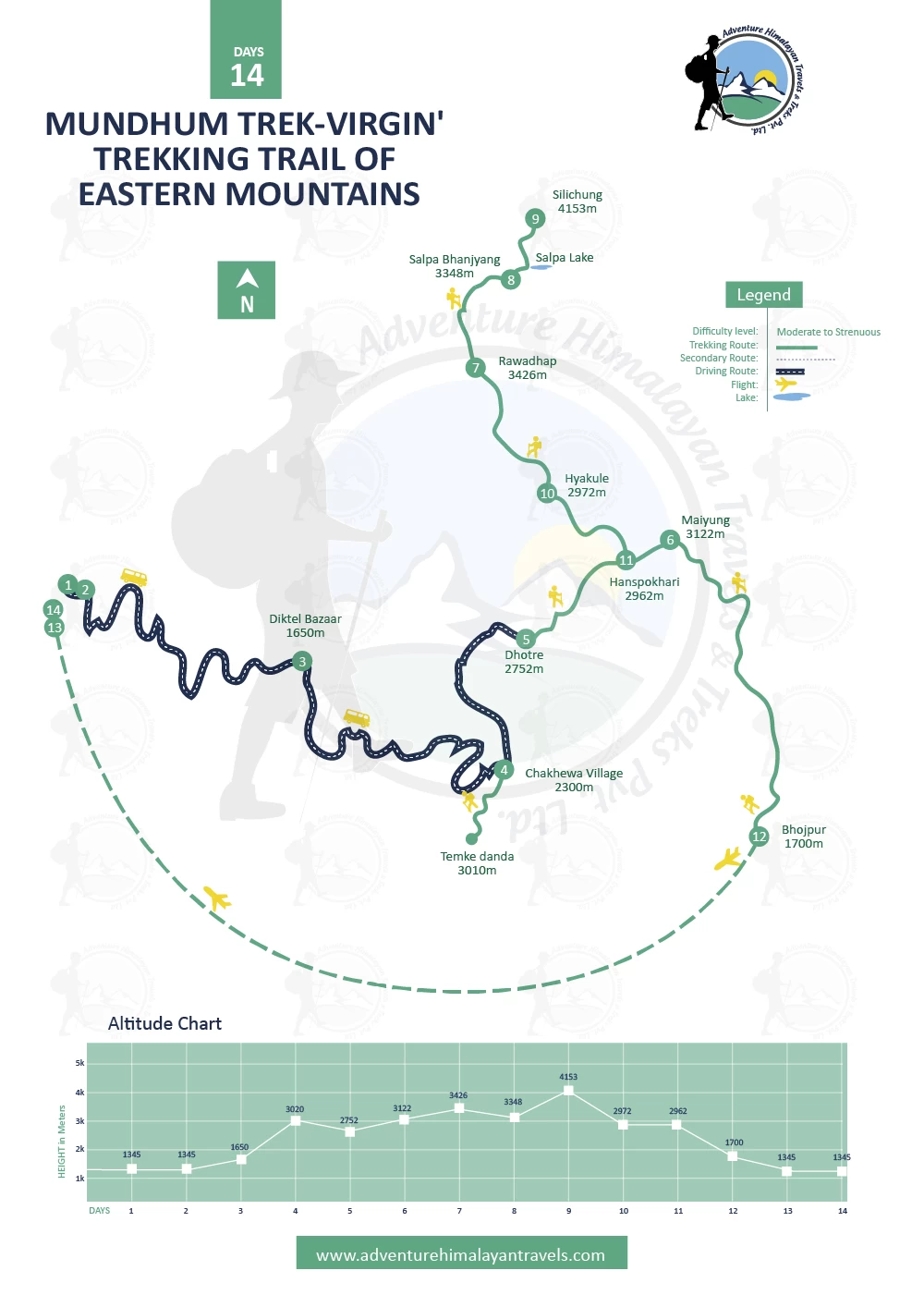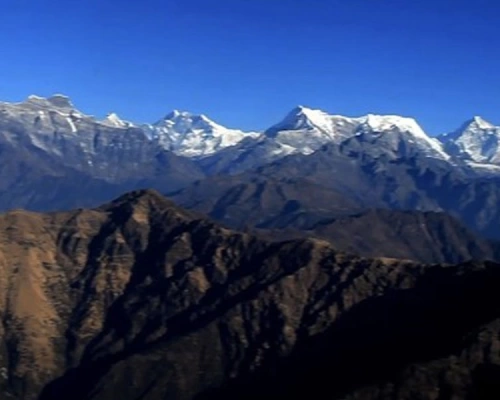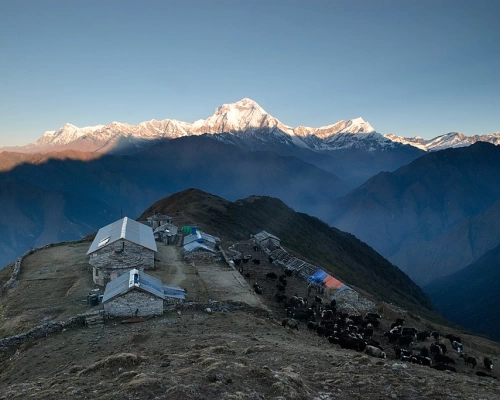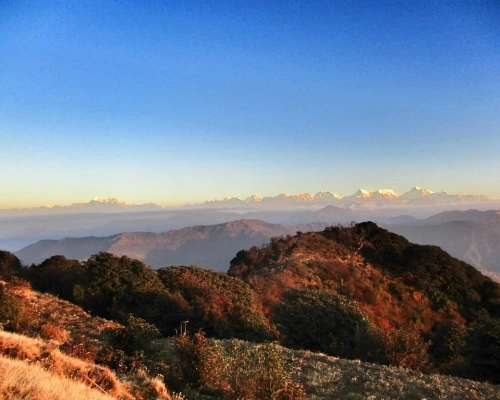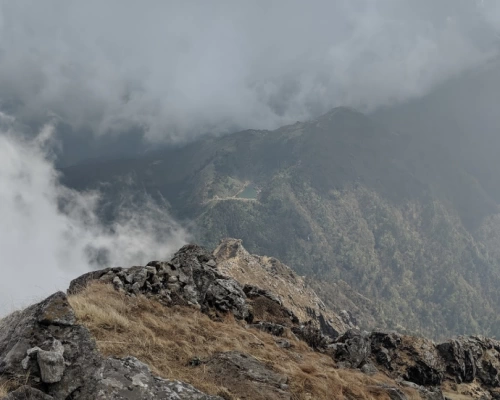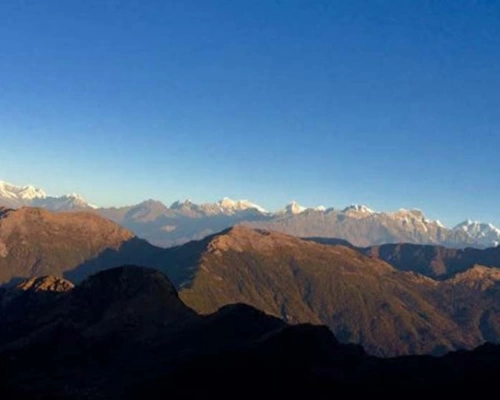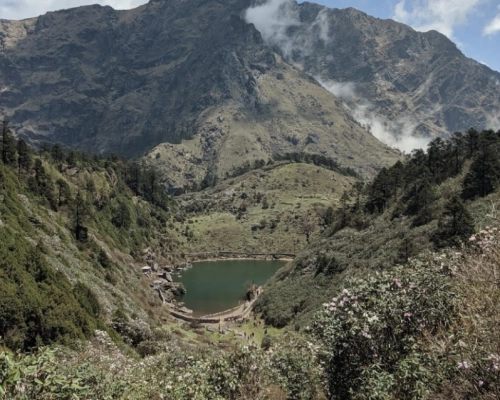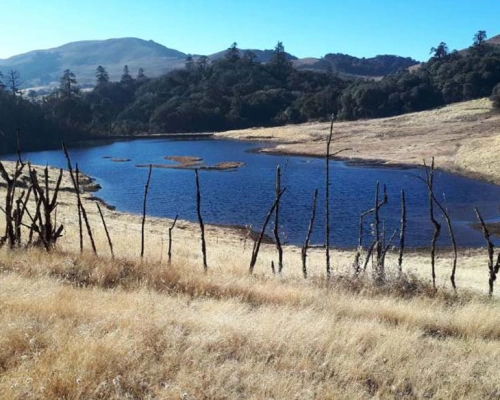The Mundhum Trek is a newly discovered, scenic, and culturally rich trekking path in the Everest Himalayas of Nepal. Named after the sacred scripture of the Kirantis, this specific route, often referred to as the Tenzing Hillary Trail, is also called the Virgin Trekking Trail. Opened only in recent years, in 2018, the trek weaves through the untouched, remote parts of the Everest Trekking Region, pristine forests, and vibrant villages predominated by Kiranti people, especially Limbus and Rais, native to the Himalayas, and is a religious destination for all the Kirantis spread over the country. They cherish this land codified as the Salpa Silicho Area while being guided by Mundhum, the four-sequence divine book that has the way of the social and cultural life of the Kirantis.
Generally, the journey to this off-the-beaten trekking route in Nepal begins with a scenic, joyous drive to Dhiktel Bazaar from Kathmandu and spans 7 to 10 days, passing by stunning small lakes, jungles of bamboo and forests, agricultural land, natural hot springs, and typical Himalayan villages. On the way, trekkers can encounter rare red pandas and various species of birds, besides observing the locals engaging themselves in their traditional way of living. Most of them are living shepherd lives invested in animal husbandry, agriculture, and some tourism.
Upon reaching the Silchung Hill, set amidst the wonders of nature and the mountains dominating the sky horizon, including Kanchenjunga, Everest, and Makalu, immersed in the spiritual essence of Kiranti traditions for ages, boasting their unique culture and lifestyle, you will be rewarded with an unmatchable sense of achievements and tranquillity. Suitable for both seasoned and beginner trekkers, the Mundhum Trek is hence a captivating and fascinating journey offering a balanced experience of the social epicenter of the Kiranti people and the elegance of the mountains and their alpine surroundings in a single trip.
Entering deep into the verdant hills, rhododendron forests, and terraced fields, showcasing the Himalayan skyline, the trekking route to Mundhum Trail embodies the true Himalayan wilderness, less traversed and crowded. Therefore, for someone seeking a more isolated and authentic trekking experience in the Himalayas, this Mundhum Trail is one of the best alternatives to the famous Everest Base Camp Trek, Annapurna Circuit, and the short Ghorepani Poon Hill Trek, offering an authentic experience of exploring the unspoiled natural and cultural richness of eastern Nepal.
What makes Mundhum Trek special?
The Mundhum Trek in eastern Nepal is a unique adventure for a reason. Starting from Diktel Bazaar, the trail passes through the various typical mountain villages, green valleys, dense forests, and swiftly changing landscapes. Throughout the journey, though you will not miss out on the most spectacular sights of Himalayan giants like Everest, Makalu, and Kanchenjunga, this trekking destination offers an equal amount of cultural and spiritual exploration.
The trail is a hidden gem and showcases the rich culture and traditions of the Kirati people and their spiritual Mundhum philosophy. Trekkers can easily access the route full of raw adventure with moderately difficult terrain and awe-inspiring views. Hence, it is a dream destination for adventurers seeking solitude in nature and cultural heritages to expect:
Explore off the beaten, unspoiled trail of the Nepalese Himalayas
Situated in the eastern hills of Nepal, at around 250-300 km/155-186 miles away from Kathmandu, based on your starting point, Hile or Bhojpur, unlike other more popular trekking destinations, the Mundhum Trek is untouched by massive tourism. Opened for tourists only in recent years, this hiking route stands out for its unparalleled pristine experience through the country’s hidden corners and culture in harmonious coexistence.
Trekkers, nature lovers, and cultural enthusiasts alike would love the silence of forests, nature in its purest form, mesmerizing Himalayan views, and the warm hospitality of the Rai and Limbu people. For those wanting to escape crowded routes, the Mundhum Trekking is just the perfect one, allowing trekkers solitude far away from the city and its chaos, leaving you with an indelible mark on your heart after completion.
Rich Cultural Experience
The Mundhum Trekking Trail features a collection of villages largely populated by Kirati in eastern Nepal. Along the route, you will stay in community-based homestays primarily managed by locals to promote sustainable tourism and also contribute to uplifting the lives of local communities. They also provide you with freshly cooked meals.
Staying in these local villages allows seamless interaction, fostering a deeper connection with the regional culture guided by Mundhum Philosophy, which is also a spiritual practice of the Limbu and Rai people rooted in animism and ancestral worship. Trekkers can observe and even participate in locals’ day-to-day activities, which are primarily agriculture and animal husbandry.
Depending on your time of visit, you might get to witness some of the grandest festivals, such as Chasok Tangnam, Dhan Naach (dance), and others celebrating the harvest seasons with dance, songs, and communal feasts, also showing vibrant costumes and intricate footwork.
Passing by the typical tiny yet beautiful villages in Dhotre, ChaKhewa, Maiyung, RawaDhap, Silchung, Hakule-Hanspokhari, Salpa Bhanjyang, and finally, Bhojpur, you get to taste authentic Limbu dishes like Kinema, Sukuti, Tongba, and others typically prepared with fresh, local ingredients, providing a farm-to-table dining experience.
Gorgeous mountain views
As you traverse the Mundhum Trekking Trail that takes you through the diverse landscapes of the Everest Himalayas and its Sagarmatha National Park, from lush green hills to alpine meadows, you will be offered unparalleled panoramic views of the alluring Himalayan range. It will be epic to witness the snow-capped, sky-towering mountain ranges playing hide and seek with you as you venture along the dense rhododendron forests, lush hills, and serene lakes.
Mount Everest, Makalu, Kanchenjunga, and Lhotse are some of the most enthralling peaks you ought to see, especially from various vantage points, such as Silichung Peak (4,200m). It also has the highest altitude gain and offers a 360-degree bird's-eye view of the surrounding Himalayas, spectacular during the sunrise and sunset when the whole alpine and pristine ambiance is covered in a golden hue.
Stretched beyond Nepal, the Mundhum Trek provides a unique perspective on familiar peaks, as well as some less heard and visited peaks across the borders of Sikkim and Tibet. Coupled with the untouched beauty of rolling hills and verdant landscapes, these sweeping views of the dramatic Himalayas make the journey worthwhile.
Biodiversity of the Sagarmatha National Park
The Mundhum Trekking route partially overlaps with the Sagarmatha National Park, a UNESCO World Heritage Site in Nepal, home to Mount Everest, the highest peak in the world. Covering an area of 1,148 square kilometers, the national park is known for its extraordinary biodiversity and is part of the legendary Khumbu Valley.
Established in the year 1976, it also features several epic Himalayan expeditions, such as the Three High Pass, Everest Base Camp, Gokyo Lake Trek, and others, including the Mundhum Trek, each offering exceptional natural beauty, biodiversity, and cultural significance, showcasing a wonderful contrast against the majestic Himalayan backdrop.
As you walk from the lower temperature zone with lush forests of rhododendron, birch, and blue pine to the subalpine zone with conifer forests featuring junipers, silver fir, and mosses, further taking you to the alpine zone that is mostly shrubland, you can spot rare wildlife such as red panda, Himalayan tahr, musk deer, and Himalayan black bear in mammals. In birds you can get to observe the Himalayan Monal (Danphe), Blood Pheasant, and Impeyan Pheasant, adding much to the trek’s appeal and paradise for naturalists.
Silichung Peak, Salpa Pokhari, Dhotre Hill, and Patal Bhanjyan
The Silichung Peak, Salpa Pokhari, Dhotre Hill, and Patal Bhanjyan are major highlights of the lesser-known but lovely Mundhum Trek. At 4,200m, the trek's highest point, the Silichung Peak, offers a complete 360-degree panoramic view of the surrounding Himalayas, including the Makalu and Kanchenjunga ranges. The lofty hill is a great spot for trekking enthusiasts, providing a challenging climb to the sacred site for the Limbu people that they visit for spiritual purposes. They believe the hill to be the abode of Sky God Paruhang.
Similarly, revered by locals, the Salpa Pokhari is a sacred alpine lake nestled in the center of the Himalayas. Surrounded by tranquil nature, locals visit the lake in search of blessings ideal for reflection and photography. Every year, many devotees visit the pond and take a dip in the belief of washing away the sins where the holy Goddess Sumina resides. In local festivals, you can watch unique rites and rituals. Additionally, trekkers can also take a side trip to a scenically rich hilltop, Dhotre Hill. It is an excellent viewpoint for soaking in the scenery and more enriching exploration of the local villages and culture and, specifically taken into consideration for sunrise and sunset, crafting the perfect stop for resting.
Yet another naturally abundant sacred site along the trekking trail to Mundhum is Patal Bhanjyan. The picturesque settlement is a cultural hub known for its religious significance, often associated with local myths and legends. Surrounded by terraced fields and forests, the area is inhabited by the Limbu community that you can observe from close during the Mundhum Trekking, offering a fantastic spiritual, cultural, and peaceful atmosphere.
The 14-day best itinerary and route for Mundhum Trek
The journey to the wild divine Mundhum Trekking begins from Diktel and is a must-do trekking trail in the Everest region of Nepal that continues through Chakhewa Bhanjyang, Maiyung, Rawadhap, Salpa Bhanjyang, and Silchung Hill, Salpa Pokhari. Initially, the route was introduced as a camping trek, where visitors would set camp amidst the tranquil Himalayan landscape with spectacular sights of Kanchenjunga, Makalu, Lhotse, Everest, and neighboring ranges. Now, much to the comfort of trekkers, you can stay in the community homestay opened and managed by locals, adding much closer insight into the unique culture and lifestyle of Kirat people.
Throughout the journey, you will get to walk past quaint yet beautiful typical villages with stone-roofed houses of diverse ethnic communities of Nepal, lush forests teeming with wildlife, including elusive red pandas, while the Silchung Hill and Salpa Pokhari serve as the major highlights for their natural beauty and cultural significance. The Silchung is the highest point of the overall trek at an altitude of 4,200 m above sea level that can be conquered by trekkers with good physical fitness regardless of their age and experience level in the high-altitude Himalayan routes. The trek ends in Bhojpur, offering rich biodiversity, ancient culture, and an adventurous, unforgettable journey through Nepal’s majestic mountains and vibrant villages, at least once must see and experience!
To sum it up, the Mundhum Trekking Trail is an ideal destination for those seeking the best of both worlds, offering a perfect mix of adventure and culture, all in two weeks. Though you can find multiple itineraries and routes, the 14 days allow you a well-paced journey without any rush, allowing thorough acclimatization, exploration, and discovery of the region's top attractions without missing any behind; hence it is considered the best route. Or, contact us for any customization on this Mundhum Trek 14-day itinerary as per your needs and preferences.
14-Day Mundhum Trek Cost 2025 and 2026
Being comparatively new, the Nepali adventure, offering spiritual peace, natural escape, and the culture of Kirat (Limbus and Rais), this unique excursion, Mundhum Trail Trek, is more affordable than some of the popular treks in Nepal, such as Upper Mustang, Annapurna Base Camp, and Everest Base Camp.
At Adventure Himalayan Travels and Treks, we are offering a group discounted price on this newly discovered trekking route to the Everest Trekking Region of Nepal. Therefore, the Mundhum Trekking Cost for 2025 and 2026 can vary based on your trekking group size, which is:
- USD 1690 for 1 pax
- USD 1590 for 2-3 pax
- USD 1490 for 4-6 pax
- USD 1390 for 7-10 pax
Our Mundhum Trek Package Cost covers expenses for all the essentials required for a smoother and priceless trekking experience, including necessary logistics like food, accommodation, permits, and guides (including their salaries, meals, and personal insurance).
Please Note: Any change in the itinerary can cause fluctuation in the package cost!
